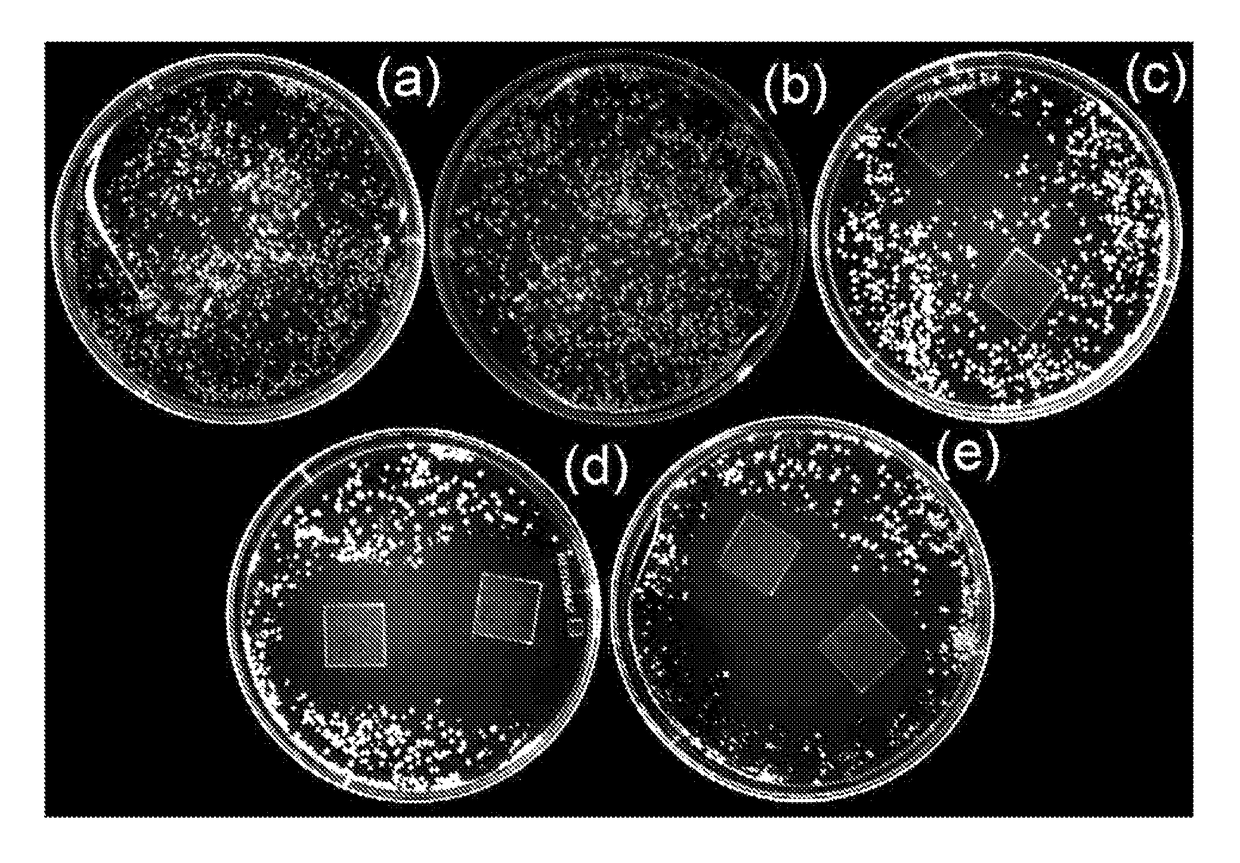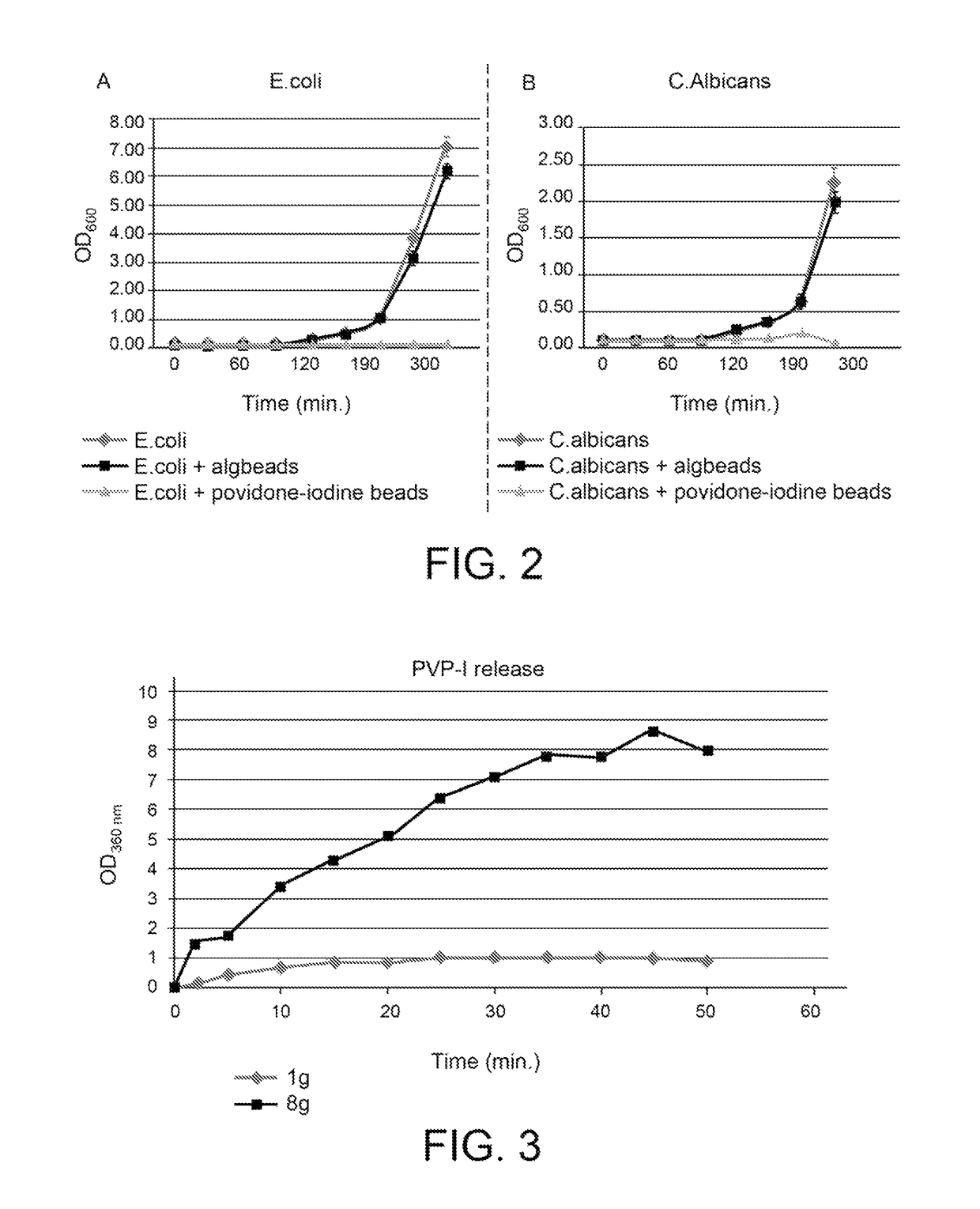Polymeric composite materials with antimicrobial and biodegradable properties and uses thereof
- Summary
- Abstract
- Description
- Claims
- Application Information
AI Technical Summary
Benefits of technology
Problems solved by technology
Method used
Image
Examples
example 1
on of a Sodium Alginate / PVPI Film
[0034]For the preparation of the composites according to the invention, the following materials were prepared: alginic acid sodium salt having a viscosity of 15000-20000 cps, glycerol≥99.5 (GC) and anhydrous sodium chloride (all purchased from Sigma-Aldrich); 100 ml of PVPI solution in water containing 10% PVPI, 1% of which was active iodine purchased from Pharmatek PMC.
[0035]Three different NaAlg-PVPI films were produced to carry out antibacterial and antifungal tests. The films were prepared as follows: 10 ml distilled water with 0.3 g NaAlg were mixed and heated by using a hot plate during 1 hour up to about 100° C., to ensure the complete dissolution of alginate in water.
[0036]Next, the viscous solution was let to cool to room temperature, and 0.1 ml glycerol as the plasticizer was added. The amount of added glycerol was kept constant in all the successive preparations of the solution. Different volumes (1.0 ml, 1.5 ml, and 2.0 ml) of a PVPI aque...
example 2
on of Calcium Alginate Microcapsules (“Beads”) and of Sutures Containing PVPI
[0043]By way of example, the above-mentioned solution, which was used for the production of the film 3 (48% NaAlg, 20% glycerol, and 32% PVPI), was used for preparing CaAlg / PVPI beads and suture threads, respectively.
[0044]For the production of the beads, the NaAlg / PVPI solution was introduced by dipping dropwise or, respectively, for the production of suture threads, it was continuously supplied by a syringe in a 10% calcium chloride solution in distilled water. The formation of the beads and the suture threads was immediate; however, the so-obtained products were left in the calcium chloride solution during 30 minutes to ensure a high cross-linking.
[0045]Next, the thus-formed materials were rinsed with distilled water to ensure the complete removal of calcium chloride traces and let to dry overnight. The cross-linking time may be varied in order to obtain a higher or lower cross-linking, as a function of ...
example 3
ssess the Antibacterial / Antimycotic Activity of Sodium Alginate / PVPI Films
[0046]In these tests, the activity of NaAlg / PVPI films coated on slides against two different microorganisms, particularly, Gram-negative bacterium E. Coli and fungus C. albicans known as the agent responsible for oral and genital opportunistic infections in humans was tested. The above-mentioned coated slides, herein below referred to as substrates, were also tested with different concentrations of bacteria and fungi to better determine the antimicrobial characteristics thereof.
[0047]In order to verify the antibacterial properties of the sodium alginate / iodopovidone films, an E. Coli culture incubated overnight with a final concentration of 8×108 cells / ml was diluted to final concentration of 106 cells / ml, and 500 μL of this solution were deposited on a plate with fresh Luria-Bertani (LB) culture medium.
[0048]Subsequently, the plates were placed in an incubator at 37° C. for two hours (to allow the evaporatio...
PUM
| Property | Measurement | Unit |
|---|---|---|
| Temperature | aaaaa | aaaaa |
| Fraction | aaaaa | aaaaa |
| Fraction | aaaaa | aaaaa |
Abstract
Description
Claims
Application Information
 Login to View More
Login to View More - R&D
- Intellectual Property
- Life Sciences
- Materials
- Tech Scout
- Unparalleled Data Quality
- Higher Quality Content
- 60% Fewer Hallucinations
Browse by: Latest US Patents, China's latest patents, Technical Efficacy Thesaurus, Application Domain, Technology Topic, Popular Technical Reports.
© 2025 PatSnap. All rights reserved.Legal|Privacy policy|Modern Slavery Act Transparency Statement|Sitemap|About US| Contact US: help@patsnap.com



